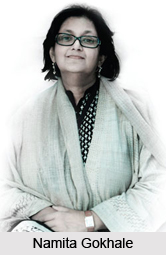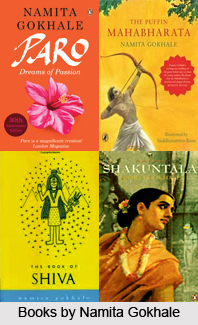 Namita Gokhale is a well renowned writer of Indian literature. She was born in the year 1956 in Lucknow, India. She spent most of her childhood in Nainital, in the lap of the nature and Himalayas and New Delhi. Namita Gokhale is a `Kumaoni` by birth. She got married at a very early age. She married Rajiv Gokhale at the age of 18 years. She discontinued her college studies over a bias issue against the curriculum of Indian literature. She has written several novels and in the late 1970s, she published "Super" from Mumbai, which was an extremely popular film magazine.
Namita Gokhale is a well renowned writer of Indian literature. She was born in the year 1956 in Lucknow, India. She spent most of her childhood in Nainital, in the lap of the nature and Himalayas and New Delhi. Namita Gokhale is a `Kumaoni` by birth. She got married at a very early age. She married Rajiv Gokhale at the age of 18 years. She discontinued her college studies over a bias issue against the curriculum of Indian literature. She has written several novels and in the late 1970s, she published "Super" from Mumbai, which was an extremely popular film magazine.
Namita Gokhale has penned down a total of five novels in English. She has also done some non-fictional work in English literature. The first novel of her literary career was "Paro: Dreams of Passion", which was brought out in the year 1984. This novel was a skit upon the Delhi and Mumbai elites. It received critical acclamation and it actually created uproar with its playful sexual humour. Next was an ironic fable titled "Gods Graves and Grandmother", which was about the street life of Delhi and it was later modified into a musical play.  Her husband was diagnosed with cancer when she was only 35 years old. After a few years her husband died which shook her completely. NThis tragic experience of the loss has some reflection in her later novels like "A Himalayan Love Story", "The Book of Shadows", "Shakuntala" and more. Two non-fiction books of Namita Gokhale are "Mountain Echoes" that deals with the Kumaoni style of life seen through the eyes of four highly artistic and individualistic women and "The Book of Shiva" for the young readers. Moreover, this talented writer has also co-edited a compilation that entirely revisits the mythology surrounding Sita in today`s contemporary culture.
Her husband was diagnosed with cancer when she was only 35 years old. After a few years her husband died which shook her completely. NThis tragic experience of the loss has some reflection in her later novels like "A Himalayan Love Story", "The Book of Shadows", "Shakuntala" and more. Two non-fiction books of Namita Gokhale are "Mountain Echoes" that deals with the Kumaoni style of life seen through the eyes of four highly artistic and individualistic women and "The Book of Shiva" for the young readers. Moreover, this talented writer has also co-edited a compilation that entirely revisits the mythology surrounding Sita in today`s contemporary culture.
amita Gokhale is also committed to translating and showcasing the best of Indian literature writing and engaging the vibrant languages of Indian sub-continent in an inventive dialogue for connecting with the rest of the world. Namita Gokhale conceptualised Neemrana 2002, the popular International Festival of Indian Literature and the famous `Africa Asia Literary Conference` in 2006. Along with renowned author William Dalrymple, she is the co-director of `Jaipur Literature Festival`. She has been completely associated with it since the time of its beginning.
Some of the popular books written by Namita Gokhale are given below -
• Paro: Dreams of Passion (1984)
• Gods, Graves and Grandmother (1994)
• Mountain Echoes: Reminiscence of Kumaoni Women (1994)
• The Book of Shadows (1999)
• The Book of Shiva (2000)
• Love Them, Loathe Them (2004)
• Present Tense, Living on the Edge (2004)
• Shakuntala, the Play of Memory (2005)
• A Himalayan Love Story (1996)
•The Puffin Mahabharata (2009)
Namita Gokhale confirms her position as one of the most reputed writers of India through her books. The write-ups of Namita Gokhale deal with unrequited love, passions, jealousies, ignorance and other common psychologies. Her work reflects startling originality and unique style of presentation. All these make her one of the most appreciated and loved writes of Indian literary arena.













